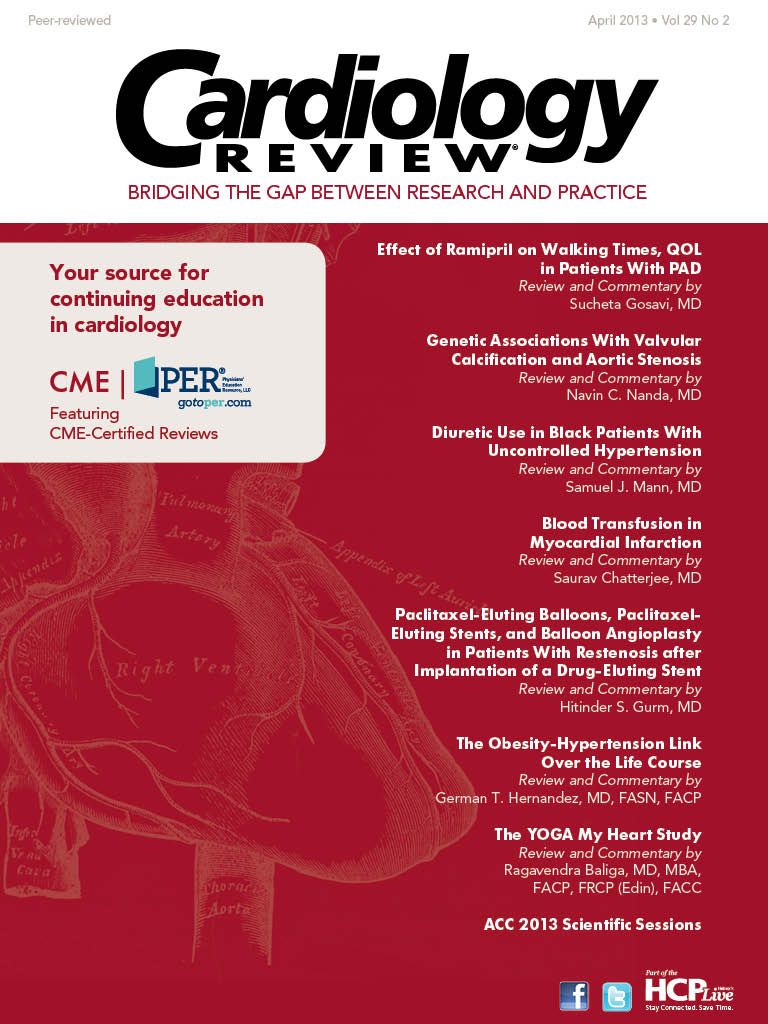Genetic Associations With Valvular Calcification and Aortic Stenosis

Navin C. Nanda, MD
Review
Study Details
One of the important sequelae of valvular calcification is the eventual development of valve stenosis, which is known to occur with aortic sclerosis where a calcified non-stenotic valve eventually becomes significantly narrowed as the patient ages. A genetic component may also be present in some patients with calcific valve disease, because the condition has been noted to be prevalent in several members of the same family.

The present study by Thanassoulis and colleagues examined genetic characteristics and their associations with aortic valve calcification evaluated by standard CT scans in a large number of individuals participating in several population-based cohort studies. They also examined the presence or absence of mitral annular calcification, which is known to be associated with increased prevalence of cardiovascular disease. In this collaborative large-scale investigation, informed consent was obtained from each participant before assessing genomewide genotype characteristics.
The analysis was performed in 2 stages. In the first stage, the genotype data were obtained from trials in which the participants were exclusively of European descent. These consisted of 6,942 individuals in whom the presence or absence of aortic valve calcification by CT scan was investigated and 3,795 individuals in whom calcification involving the mitral annulus calcification was similarly examined. The findings obtained from meta-analysis of the first stage were further tested in a cohort that consisted of not only white Europeans, but also African Americans, Chinese Americans, and Hispanic Americans. In a subset of these participants in the second stage of the study, data regarding the presence or absence of clinical aortic stenosis were available for correlation with genotype findings. Plasma lipoprotein(a) [Lp(a)] levels were evaluated in another subset of individuals and these were also correlated with genetic characteristics.
Strict quality-control measures were instituted for genotyping and data acquisition, and to provide uniformity and standardization given that multiple sites were involved. The criterion used for the assessment of calcification by CT scanning was also standardized, and a brightness of at least 130 Hounsfield units in 3 or more contiguous pixels was used to indicate its presence. Any calcification noted in the aortic leaflets or commissures and along the circumferential aspect of the mitral annulus satisfied the criterion for the presence of calcification and was used for correlation in the analysis. Standard contemporary statistical methods were used for analysis of the results.
The results of this study showed that a single nucleotide polymorphism (SNP) designated as rs10455872 located within intron 25 of LPA on chromosome 6 was significantly associated with the presence of aortic valve calcification in individuals of European ancestry. The odds for this SNP for aortic valve calcification were increased by a factor of 2 when adjustments were performed for the age and gender of the participants. In the ethnic groups studied in the second phase, SNP rs10455872 was significantly associated with aortic valve calcification in African Americans and Hispanic Americans but not in Chinese Americans. In subset analysis, rs10455872 was significantly associated with aortic valve stenosis. It was also significantly associated with plasma Lp(a) levels that, in turn, had a significant correlation with aortic valve calcification.
As far as mitral annular calcification was concerned, 2 different SNPs located on chromosome 2, designated rs17659543 and rs13415097, had a significant association. Analysis of the ethnic groups showed a statistically significant association of SNP rs17659543 with mitral annular calcification in Hispanic Americans but not in those of European descent and other ethnic groups.
Commentary A Landmark Study of Genetics and Aortic Valve Calcification
The results of this study are most interesting. A specific SNP, rs10455872, was associated with aortic valve calcification in an analysis of a large number of participants taken from multiple population-based trials. This was shown not only in individuals of European ancestry but also in other ethnic groups, in particular African Americans and Hispanic Americans. A notable exception was Chinese Americans. However, this conclusion regarding the other ethnic groups has to be tempered by the low statistical power on account of the relatively small sample size of the ethnic populations included in the study. This association of SNP rs10455872 was independent of coronary artery calcification by CT scan and clinical coronary artery disease in a subset of cohorts studied.
Also of great interest in this study is the strong and independent association of this nucleotide polymorphism with aortic valve stenosis as well as plasma Lp(a) levels that, in turn, were significantly associated with aortic valve calcification. Previous studies1-4 have demonstrated an association of increased plasma Lp(a) levels with aortic valve disease, but this is the first study to show evidence for a causal relationship between the 2, and implicates a genetic factor. Lp(a) levels in this study were causally associated with an increase of about 62% in the odds for aortic valve calcification per log-unit increment in Lp(a). The mechanism may be similar to coronary artery disease, where Lp(a)—widely regarded as a risk factor—accumulates in the vessel intima and leads to a prothrombotic state.5 In aortic valve disease, Lp(a) could possibly deposit in the leaflets, especially at the sites of coaptation where mechanical injury to the endothelium from repetitive contact is a possibility.6 The authors of the present study suggest that increased Lp(a) levels present for a long time may predispose an individual to aortic valve calcification, eventually leading to aortic valve stenosis. This opens up interesting possibilities from the therapeutic point of view. Lowering plasma Lp(a) levels in an individual at an early stage could conceivably prevent or delay the development of aortic valve calcification and stenosis. Although therapeutic regimens for lowering Lp(a) levels are currently scarce and of limited efficacy, interesting new agents may be on the horizon.
In addition to aortic valve calcification, a significant association of an SNP with mitral annular calcification was noted by the authors of this study. In the second phase of the investigation, the association was found to be positive in Hispanic Americans but not in Europeans and other ethnic groups. However, as the authors themselves point out, the reliability of this finding is questionable and further studies are needed with a much larger number of participants for verification.
The study has some limitations. It would have been more useful and might have provided further insight if the investigators had performed quantitative or semi-quantitative tests on the amount of calcification present in the aortic valve leaflets and commissures as well as in the mitral annulus. The authors simply assessed the presence or absence of any calcification in these areas. Also, assessment and analysis of calcification in adjacent areas such as the aortic annulus, ascending aorta, and mitral valve leaflets could have provided important information. Furthermore, no intra- or interobserver variability studies were performed in the assessment of calcification by CT scanning, to take into account the fact that studies were analyzed from multiple sites. It is also not clear whether a single core laboratory was used for all analyses.
Despite these limitations, this is a landmark study that has identified a specific SNP, rs10455872, significantly associated with aortic valve calcification and aortic valve stenosis. The study’s findings also implicate elevated plasma Lp(a) levels in the development of aortic valve disease.
References
1. Bozbas H, Yildirir A, Atar I, et al. Effects of serum levels of novel atherosclerotic risk factors on aortic valve calcification. J Heart Valve Dis. 2007;16:387-393.
2. Glader CA, Birgander LS, Soderberg S, et al. Lipoprotein(a), chlamydia pneumonia, leptin and tissue plasminogen activator as risk markers for valvular aortic stenosis. Eur Heart J. 2003;24:198-208.
3. Gotoh T, Kuroda T, Yamasawa M, et al. Correlation between lipoprotein(a) and aortic valve sclerosis assessed by echocardiography (the JMS Cardiac Echo and Cohort Study). Am J Cardiol. 1995;76:928-932.
4. Stewart BF, Siscovick D, Lind BK, et al. Clinical factors associated with calcific aortic valve disease: Cardiovascular Health Study. J Am Coll Cardiol. 1997;29:630-634.
5. Miles LA, Fless GM, Levin EG, Scanu AM, Plow EF. Potential basis for the thrombotic risks associated with lipoprotein(a). Nature. 1989;339:301-303.
6. Nielsen LB, Stender S, Kjeldsen K, Nordestgaard BG. Specific accumulation of lipoprotein(a) in balloon-injured rabbit aorta in vivo. Circ Res. 1996;78:615-626.
About the Author
Navin C. Nanda, MD, is Distinguished Professor of Medicine and Cardiovascular Disease and Director of the Heart Station/Echocardiography Laboratories of the University of Alabama at Birmingham. He is also Director of the Echocardiography Laboratory at the Kirklin Clinic, University of Alabama Health Services Foundation. Dr. Nanda has received many awards for service and achievement in medicine and is the author of numerous publications.
Thanassoulis G, Campbell CY, Owens DS, et al. Genetic associations with valvular calcification and aortic stenosis. New Eng J Med. 2013;368:503-512.
